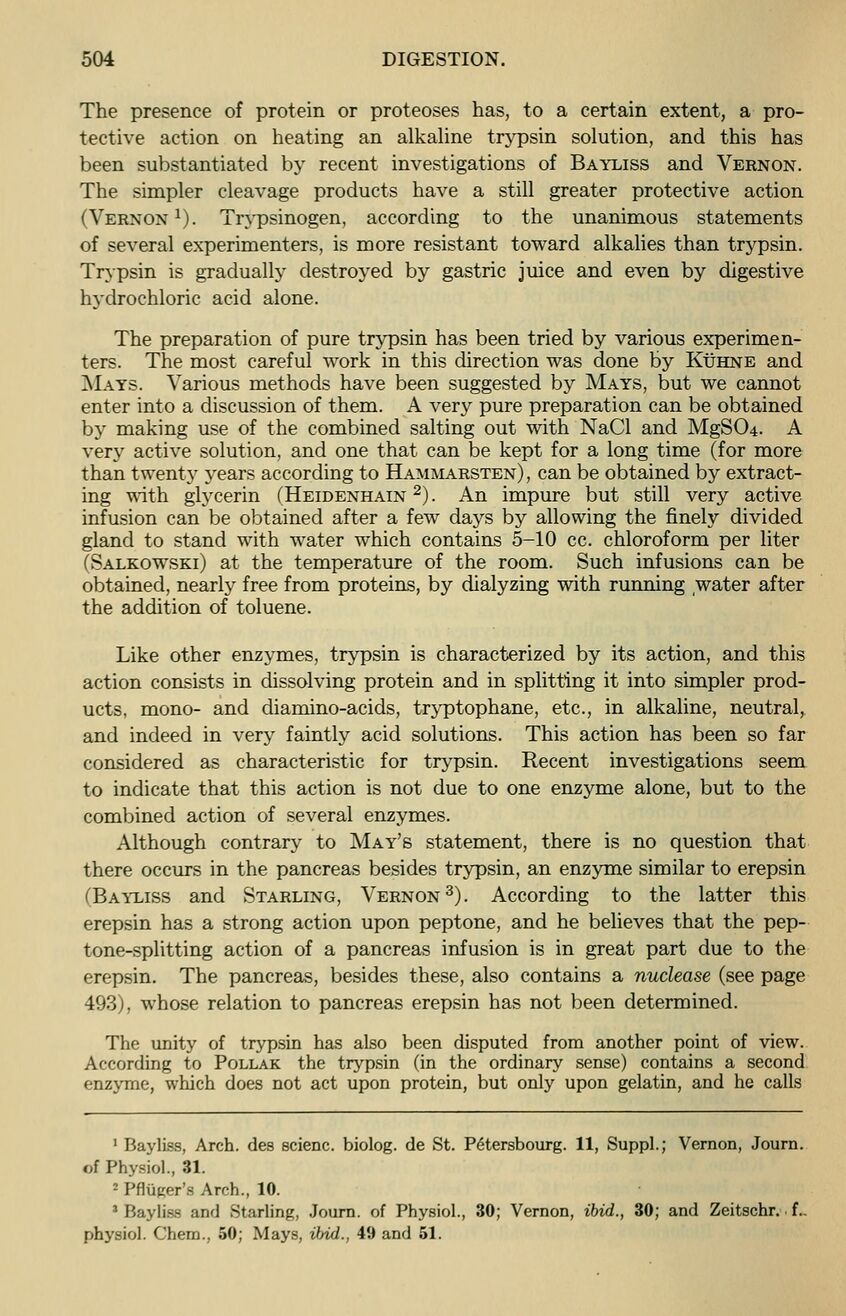
Full resolution (JPEG) - On this page / på denna sida - VIII. Digestion - IV. The Pancreas and Pancreatic Juice

<< prev. page << föreg. sida << >> nästa sida >> next page >>
Below is the raw OCR text
from the above scanned image.
Do you see an error? Proofread the page now!
Här nedan syns maskintolkade texten från faksimilbilden ovan.
Ser du något fel? Korrekturläs sidan nu!
This page has never been proofread. / Denna sida har aldrig korrekturlästs.
504 DIGESTION.
The presence of protein or proteoses has, to a certain extent, a pro-
tective action on heating an alkaline trypsin solution, and this has
been substantiated by recent investigations of Bayliss and Vernon.
The simpler cleavage products have a still greater protective action
(Vernon 1
). Trypsinogen, according to the unanimous statements
of several experimenters, is more resistant toward alkalies than trypsin.
Trypsin is gradually destroyed by gastric juice and even by digestive
hydrochloric acid alone.
The preparation of pure trypsin has been tried by various experimen-
ters. The most careful work in this direction was done by Kuhne and
[Mays. Various methods have been suggested by Mays, but we cannot
enter into a discussion of them. A very pure preparation can be obtained
by making use of the combined salting out with NaCl and MgSO-i. A
very active solution, and one that can be kept for a long time (for more
than twenty years according to Hammarsten), can be obtained by extract-
ing with glycerin (Heidenhain 2
) . An impure but still very active
infusion can be obtained after a few days by allowing the finely divided
gland to stand with water which contains 5-10 cc. chloroform per liter
(Salkowski) at the temperature of the room. Such infusions can be
obtained, nearly free from proteins, by dialyzing with running water after
the addition of toluene.
Like other enzymes, trypsin is characterized by its action, and this
action consists in dissolving protein and in splitting it into simpler prod-
ucts, mono- and diamino-acids, tryptophane, etc., in alkaline, neutral,
and indeed in very faintly acid solutions. This action has been so far
considered as characteristic for trypsin. Recent investigations seem
to indicate that this action is not due to one enzyme alone, but to the
combined action of several enzymes.
Although contrary to May’s statement, there is no question that
there occurs in the pancreas besides trypsin, an enzyme similar to erepsin
(Bayliss and Starling, Vernon 3
). According to the latter this
erepsin has a strong action upon peptone, and he believes that the pep-
tone-splitting action of a pancreas infusion is in great part due to the
erepsin. The pancreas, besides these, also contains a nuclease (see page
493), whose relation to pancreas erepsin has not been determined.
The unity of trypsin has also been disputed from another point of view.
According to Pollak the trypsin (in the ordinary sense) contains a second
enzyme, which does not act upon protein, but only upon gelatin, and he calls
1
Bayliss, Arch, des scienc. biolog. de St. Petersbourg. 11, Suppl.; Vernon, Journ.
of Physiol., 31.
- PfluKer’s Arch., 10.
* Bayliss and Starling, Journ. of Physiol., 30; Vernon, ibid., 30; and Zeitschr. . f..
physiol. Chem., 50; Mays, ibid., 49 and 51.
<< prev. page << föreg. sida << >> nästa sida >> next page >>